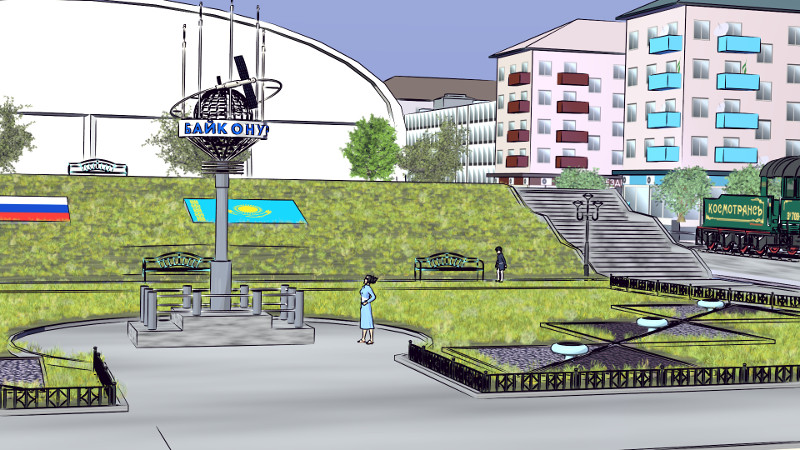Creating the Town of Baikonur in 2040
Our cover image this month is the just-completed “Baikonur Train Station Exterior” set, one of three large exterior sets of the town of Baikonur planned for the “Prolog” mini-episode (and the pilot “No Children in Space” of which it is a part).
One of the purposes of this sequence is to offer some grounding and connection for the series, as well as to establish the graphical look-and-feel — the amount of stylism versus realism to expect — in a more familiar Earth setting, before taking on space and the Moon.
The logical place to do this, without stretching the story out excessively, is to work with the last couple of days on Earth, which Hiromi and Georgiana spend in Baikonur, Kazakhstan — the “spaceport town” that supports the Baikonur Cosmodrome. It’s an odd little town, in the middle of the semi-desert steppe of Western Kazakhstan — a very isolated place, with many miles of virtually-uninhabited desert on all sides.
Despite this, it is uncommonly well-connected, having both railway access and a real airport, as well as hotels and other features well-above what you’d expect for a town that is so small and remote. It’s also dotted with memorials, mostly dating from the height of the Soviet space program, but also with a few more modern ones. Its architectural is unusual, and the artistic styles have a strong legacy of the Soviet socialist propaganda art movement. For an artist, whatever you might think of the politics, it’s a beautiful thing to look at. For example, take a look at this reproduction of the mural on the walls at the “Glory to the Conquerors of Space” monument, depicting the history of air and space development:
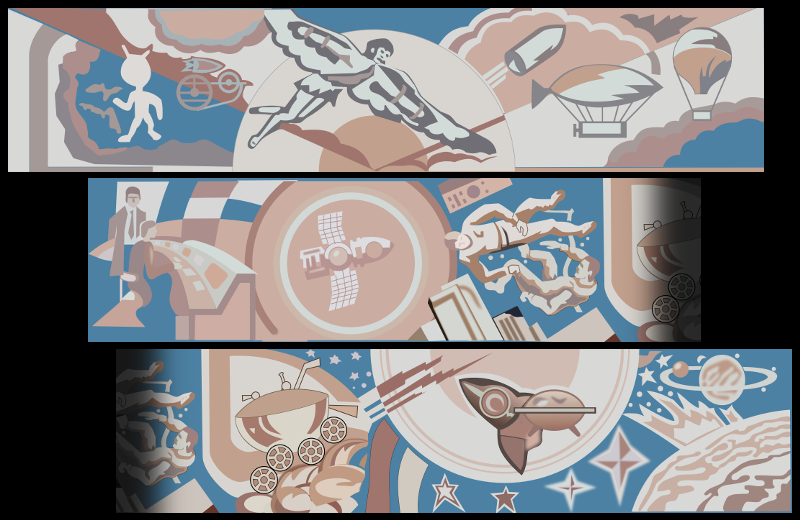
together from tourist photos — this is my reproduction of it in Inkscape. And no, I don’t
know why the sequence starts with what appears to be a stereotypical “space alien” — the
artists’ idea of a joke, perhaps.
Of course, there is just one problem: none of us has actually been to the Baikonur Cosmodrome, the nearby town of Baikonur, nor even the entire country of Kazakhstan. We don’t have the budget to go there (I wish!).
We could make it completely invented, of course — our American audience, at least, probably would not notice. But part of the concept for the series is international release — and I’d like to make the attempt to at least not be completely laughable to audiences in Kazakhstan or Russia, nor to space-savvy audiences who have seen these places in countless NASA and RosCosmos videos online.
So I made an extensive study of available photography online, using Flickr, Google Maps (including submitted tourist photos), and the NASA and RosCosmos videos and photos we’d probably be compared to.
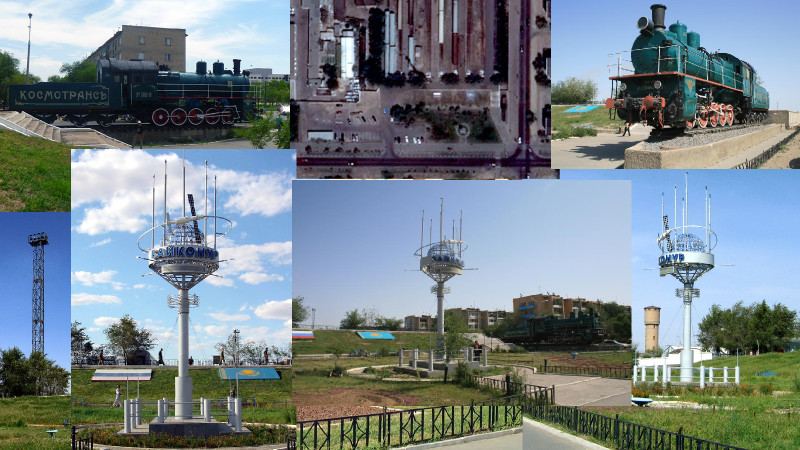
Of course, we made a special effort on the space hardware and launch site, but since our story starts from the point of view of a seven-year-old girl for whom all of this stuff is new and interesting, I wanted to show more of the “mundane” aspects of the trip, as if Hiromi and Georgiana were just on a sightseeing holiday.
There is also a kind of “fairy-tale lens” that I’m trying to give to the place, as we are seeing it through Georgiana’s memory of a very exciting and defining moment in her life. So in some cases, I’ve made the models a little more ideal-looking than the real thing. Also, we’re optimistically assuming that the space industry and tourism has brought money to a spaceport town like Baikonur over the 25 years between our present and the time of the story, and that this has been reflected in civic improvements.
Partly for this reason, and also partly because of the sound I wanted to use in the scene, our train station has a (newly built?) indoor train platform, instead of the open-air platform that exists there today. You can see the domed roofs of the platforms in the back of our image.
Characters: Concept to Animation
No matter how good the sets and props are, though, our project will live or die on how well we realize our characters. This has been a long, hard process, and it’s the part of the project for which I’ve been most dependent on other people’s talents.
Knowing this, we decided to put the first funds from the project into character design — commissioning comic artist Daniel Fu, first to create a series of concept drawings based on descriptions and reference photos that we (Rosalyn Hunter and Terry Hancock) came up with based on our concepts for the characters. Then of course, we moved on to modeling and rigging these characters. This is the biggest part of what we are still working on for the project, which is why there are relatively few character shots available so far.
It’s also an area that can be very touchy. Our characters sit fairly close to the “uncanny valley”, and it’s easy to slip over the boundary. We don’t want to drive anyone away from the project with not-quite-ready characters, so I’ve been slow to release these. However, I think we’re getting close to finished with the Georgiana and Hiromi characters (who figure prominently in the pilot episode), and so I thought it would be cool to show a multi-stage visual comparison of the development work to date on these two characters.
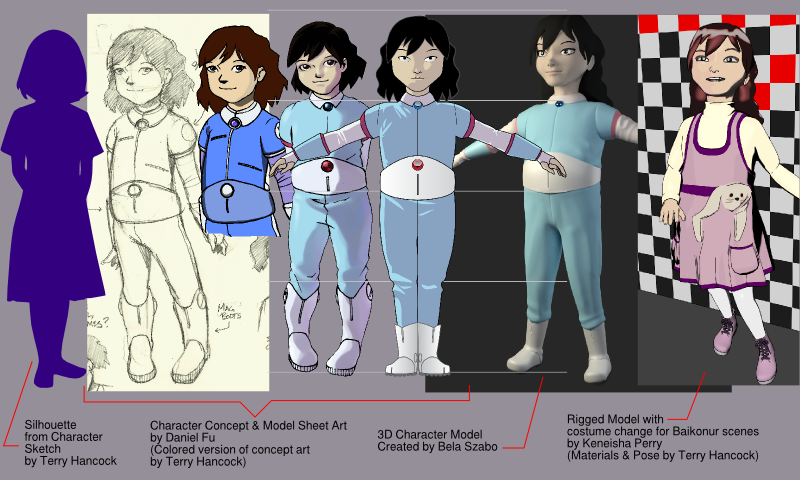
We started by mocking up “silhouette” versions of the characters based on public-domain art and modifications from photos and so on. These were among the sources Daniel had to start with. Of course, once he made his updated portraits for us, we converted to using silhouettes of his versions of the characters, which were already a remarkable improvement.
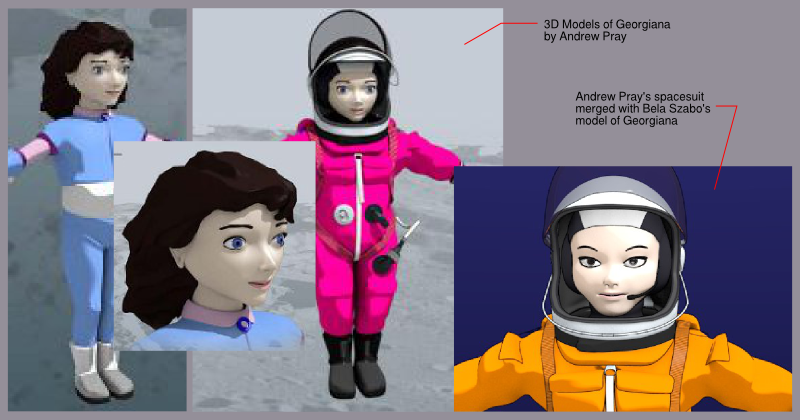
In 2012, when were hoping for a fast startup, Andrew Pray joined the project with a lot of enthusiasm, contributing our first 3D character models. These did not follow the modelsheets as closely as the current models. However, when the funding from that cycle didn’t go through and it became evident that this was going to be a long, slow project, Andrew left to attend art college, which left us with a bit of a quandary, since his contribution had significantly altered the character concept. In the end, I decided to scrap the few face models he had created and start over, staying closer to the modelsheets with Bela Szabo as our new character modeler — who has done fantastic work, and is probably the one most responsible for the current look of the characters. However, Andrew’s spacesuit models were excellent and compatible enough that we could just adapt them. So our current Spacesuited Georgiana model owes as much to Andrew’s work as to Bela’s.
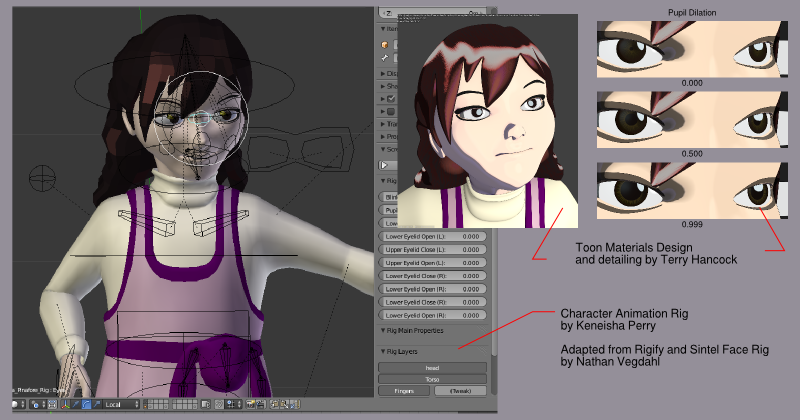
Unposed character models with default “plastic” textures look very unimpressive to audiences, so we haven’t really been able to show off all of the character modeling work as much as we would like. Also, after looking at early results with these models, I decided that I really needed to work harder on getting the “toon” look for the characters that I had been hoping for. So, I put a lot of work into materials for the Georgiana character. And finally, of course, the characters need body and face animation rigs. We were hoping to be able to use an existing rig for this, but the best we could do was to adapt the Rigify body rig and a modified version of the face rig used for Sintel (in the Blender Open Movie of the same name). Keneisha Perry was just learning Blender rigging at that point, but put a lot of effort into it, and we we now have an excellent rig for the Georgiana character. Furthermore, we can use this rig as a basis for all of the character rigging for our production.
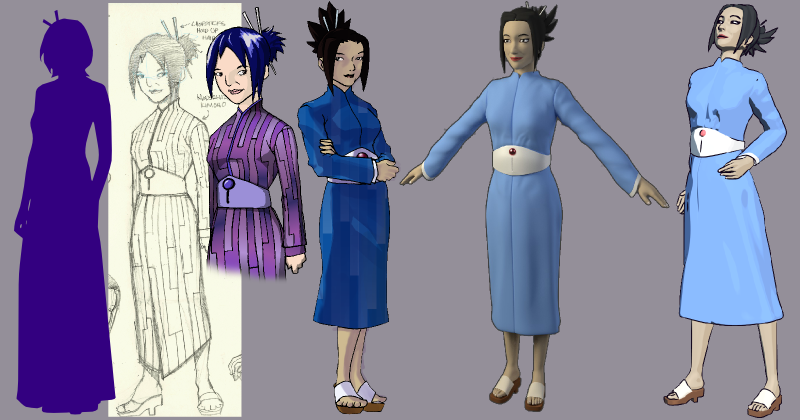
Last month, I shared some tests of facial animation, and this month I can show a simple body animation — of Georgiana skipping. This is for a brief cut we’re going to use in the Preview animation of Georgiana skipping through the train station set shown on this month’s cover. Obviously, the prolog is going to require a lot more animation than this!
Setting Goals for 2015
Since we’ve achieved essentially all of the technical/workflow milestones required for the production of our pilot episode, I feel a lot more confident that I can make realistic predictions about our goals and schedules this year.
On the other hand, we have not been able to get significant funding or volunteer support for the project. So at this point, I’m having to base my predictions on the existing team, working on a spare-time basis. With this in mind, I’ve had to scale back considerably in what we can accomplish in 2015. But on the other hand, I feel a lot more confident that we will accomplish it.
Production Schedule for 2015
What to expect:
- Feb 13
- Our three-minute “Preview” will be released on Patreon before the February newsletter
(I did not manage to finish it by the end of the year, obviously, but it is nearly completed already) - Apr 12
- Our “Prolog” episode (the first of three comprising the pilot, “No Children in Space”) should be completed by early April — hopefully in time for a “Yuri’s Night” release on April 12th
- Jul 20
- We’ll be working on the “Pilot/Act 1” episode, with a goal of releasing in the Summer, possibly by “Moon Day” on July 20th
- Oct 4 – Dec 31
- Although we might shoot for releasing “Pilot/Act 2” by “Space Week” October 4th, if things are going very well, I’m more confident in predicting that we’ll finish it before the end of the year. And of course, when we complete this part, we’ll release the entire “No Children in Space” as one full-length episode as well
- Dec 31 – Feb, 2016
- If we do finish the pilot in October, we’ll make an attempt to finish “Earth” in December. Otherwise, we’ll be working on that in 2016
I do have modest commitments for 2015 work. Keneisha Perry will be continuing to develop our “Walk-On” and “Extras” characters for the “Prolog” segment and Chris Kuhn will be working with me this Spring on the “Space Station Alpha” exteriors for the “Pilot/Act 1” segment. I will be working on most of the sets. Later this month, I’ll be catching up with Bela Szabo and Sathish Kumar on additional tasks for the “Act 1” and “Act 2” segments
I am still hoping that a release will give us a means of raising more funds. If at any point that happens, we should be able to speed up production by dedicating more time to the project and possibly recruiting professional modeling and animation help through Blender job boards online.
Project Changes for 2015
As we are on track to release content this year, I will also be opening up some more revenue and tie-in options:
Patreon Monthly OptionIn addition to the per-episode page, we’ll add a monthly subscription page for those who would prefer a smaller, more predictable payment.Web Merchandise StoreA web store for tie-in merchandise. We’re looking into some low-budget/no-budget options that won’t have too much overhead costs to maintain.Other MerchandiseSpecialized merchandise on print-to-order sites: an updated Writer’s Guide, 3D-printed figures or models on Shapeways, and Lunatics-themed fabric on Spoonflower.Redesigned WebpageThis is really overdue. Our website looks quite dated, and it’s not very mobile-friendly.
Ideally, I would love for someone more in touch with modern design to help us with this. It won’t happen right away, though, because my focus is on getting the Prolog episode finished. Possibly a good project for this Summer.
Lunatics has always been an ambitious, experimental project, and we are going to be trying yet more things in our quest to find the right formula a commercial free-culture success. We’re clearly not going to be releasing a dozen or more episodes this year, as we had earlier hoped, but we’ll keep working on it, and hopefully we’ll reach a point where things turn around, and we start accelerating on our production. This could be the year that happens. I’m certain it will be the year that we release our first animated episodes, and that is very exciting to me.
Credits for this Month’s Cover:
| Monument for Train Station Set | Sathish Kumar |
| Display Steam Train | Chris Kuhn |
| Character Design | Daniel Fu |
| Character Models | Bela Szabo |
| Character Wardrobe Armature Rig & Weight Paint |
Keneisha Perry |
| Set Modeling, Textures & Materials Character Poses |
Terry Hancock |
(Converted from January 2014 Patreon Newsletter, 2025-10-24)
